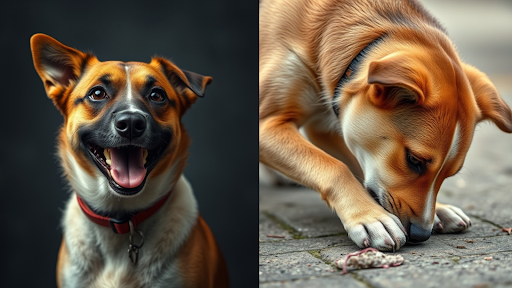A dog or any other pet relies on body language cues, behaviours and vocalizations to communicate with their parents. Observe these cues carefully to understand what your dog is trying to say. Your cute little furry friend is trying to express their emotions, needs, and desires. If you know how to interpret these signals, you can better address your dog’s needs. Use these behavioural cues to develop a happier and healthier relationship with your dog. The following are the most common ways dogs communicate with their owners:
Understanding Your Dog’s Body Language
Recognizing your dog’s body language can help you understand their feelings and respond appropriately. Dogs use their tails, ears, eyes, body posture, and mouth to convey emotions. Here are some key cues to watch for:
Tail Position and Movement
A dog’s tail can reveal much about their emotional state:
- Wagging: Generally indicates excitement or friendliness. A slow wag may signal caution, while a fast, broad wag typically shows happiness.
- Tail Tucked Between Legs: This is a sign of fear, anxiety, or submission, often seen when a dog feels unsure or intimidated.
- Tail Held High and Stiff: A raised, stiff tail may indicate alertness or dominance, sometimes signalling aggression if paired with tense body language.
Ear Position
While ear positions vary by breed, certain cues indicate emotions:
- Ears Perked Forward: This shows curiosity or focus on something specific.
- Ears Pinned Back: Often a sign of fear, submission, or discomfort.
- Relaxed Ears: Indicates calmness and comfort. Persistent anxiety, shown through ear position or other cues, may suggest the need for behaviour modification for dogs.
Eye Contact and Gaze
Eye contact in dogs can communicate trust, submission, or even aggression:
- Direct, Soft Eye Contact: Shows trust and affection, often seen when a dog feels secure.
- Avoiding Eye Contact: Indicates submission or discomfort, common in anxious dogs.
- Hard Stare: A hard, unblinking stare is often a warning. If observed, avoid sudden movements and back away calmly.
Body Posture
Posture can show if a dog is relaxed, tense, or fearful:
- Relaxed Body: A loose, soft posture indicates a dog is comfortable.
- Rigid or Stiff Posture: This signifies tension or a sense of threat, often accompanied by alertness.
- Crouching: Shows fear or submission, frequently with tucked ears and tail.
Observing body posture can help you recognize situations that make your dog uncomfortable. For example, if your dog appears tense in certain places or around certain people, behaviour modification for dogs can help ease these fears.
Mouth and Facial Expressions
A dog’s mouth and facial expressions can reveal stress or relaxation:
- Relaxed Mouth: A slightly open mouth indicates calmness; some dogs even “smile” when happy.
- Panting: While panting can mean a dog is hot, it may also indicate stress if it occurs in a relaxed environment.
- Baring Teeth or Growling: A dog showing its teeth or growling signals discomfort or territorial feelings. Give them space if you see this.
Play Signals
Play is essential for dogs, and they use specific cues to show they want to engage:
- Play Bow: Front legs stretched out, rear in the air—this universal sign shows a dog is ready to play.
- Bouncing or Pouncing: Dogs often jump around energetically to invite play, a positive sign of excitement.
If your dog has had issues with aggression or anxiety, a behaviour modification course can help encourage healthy play interactions.
Self-Soothing Behaviors
Dogs sometimes exhibit self-soothing behaviours in response to stress:
- Yawning: While yawning is normal, it may indicate stress, especially in new situations.
- Licking Their Lips: Lip licking, unrelated to eating, is often a sign of nervousness.
- Scratching or Shaking Off: This can be a way to release tension after a stressful event.
Conclusion
Understanding your dog’s body language fosters a strong bond and ensures their well-being. Dogs communicate complex emotions through posture, expressions, and movements. By becoming more aware of these cues, you can create a supportive environment for your pet.
If your dog has specific behavioural challenges, a behaviour modification course can provide tools to address unwanted habits. You’ll learn to interpret your dog’s unique expressions with patience, leading to a happier, more connected relationship.
For more information visit: https://flywiththought.com/





